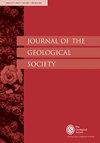Cuesta de Rahue基底Inlier (south neuqu Precordillera,阿根廷):巴塔哥尼亚北部泥盆纪至三叠纪多相造山记录
IF 3
3区 地球科学
Q2 GEOSCIENCES, MULTIDISCIPLINARY
引用次数: 1
摘要
提供了Cuesta de Rahue基底Inlier中暴露的火成变质岩的新的地质、结构、微观结构和K-Ar黑云母和伊利石地质年代数据,以重建巴塔哥尼亚西北部晚古生代至中生代的构造变质和岩浆史。该区块包括一个中等级别的变质沉积序列(Cuesta de Rahue变质杂岩)、晚石炭世花岗质岩石和一个低级别的变质火山沉积单元(Arroyo Coloco变质杂岩体)。Cuesta de Rahue变质杂岩沉积于古生代中期,经历了泥盆纪低压区域变质作用,随后在约300 Ma发生了花岗岩类侵入。另一方面,Arroyo Coloco变质杂岩记录了表带条件(>300°C)下的变形和变质作用,受K-Ar和XRD伊利石数据的限制,在约232-199 Ma。因此,Cuesta de Rahue基底Inlier记录了漫长的造山演化,记录了泥盆纪变质作用、晚石炭世-二叠纪冈瓦纳构造岩浆作用以及晚三叠纪变形和变质作用。之后,该地块还受到中生代正断层的影响,最后受到中新世-上新世-安第斯变形的影响。后者与继承基底构造的再活化密切相关,有利于转换挤压变形机制。补充材料:https://doi.org/10.6084/m9.figshare.c.6484467本文章由计算机程序翻译,如有差异,请以英文原文为准。
The Cuesta de Rahue Basement Inlier (Southern Neuquén Precordillera, Argentina): A Devonian to Triassic polyphase orogenic record in northern Patagonia
New geological, structural, microstructural, and K-Ar biotite and illite geochronological data of igneous-metamorphic rocks exposed in the Cuesta de Rahue Basement Inlier are presented to reconstruct the Late Palaeozoic to Mesozoic tectonometamorphic and magmatic history of northwestern Patagonia. This block comprises a medium-grade metasedimentary sequence (Cuesta de Rahue Metamorphic Complex), Late Carboniferous granitoids and a low-grade metavolcano-sedimentary unit (Arroyo Coloco Metamorphic Complex). The Cuesta de Rahue Metamorphic Complex was deposited during the middle Palaeozoic and underwent Devonian low-pressure regional metamorphism, succeeded by the intrusion of granitoids at ca. 300 Ma. On the other hand, the Arroyo Coloco Metamorphic Complex record deformation and metamorphism at epizonal conditions (> 300 °C), constrained at ca. 232-199 Ma by K-Ar and XRD illite data. The Cuesta de Rahue Basement Inlier thus records a protracted orogenic evolution, recording Devonian metamorphism, Late Carboniferous-Permian Gondwanide tectonomagmatic processes, and Late Triassic deformation and metamorphism. Afterwards, this block was also affected by Mesozoic normal faulting and, finally, by Miocene-Pliocene Andean deformation. The latter was intimately related to reactivation of inherited basement fabrics, favouring a transpressional deformation regime.
Supplementary material:
https://doi.org/10.6084/m9.figshare.c.6484467
求助全文
通过发布文献求助,成功后即可免费获取论文全文。
去求助
来源期刊

Journal of the Geological Society
地学-地球科学综合
CiteScore
6.00
自引率
3.70%
发文量
68
审稿时长
6-12 weeks
期刊介绍:
Journal of the Geological Society (JGS) is owned and published by the Geological Society of London.
JGS publishes topical, high-quality recent research across the full range of Earth Sciences. Papers are interdisciplinary in nature and emphasize the development of an understanding of fundamental geological processes. Broad interest articles that refer to regional studies, but which extend beyond their geographical context are also welcomed.
Each year JGS presents the ‘JGS Early Career Award'' for papers published in the journal, which rewards the writing of well-written, exciting papers from early career geologists.
The journal publishes research and invited review articles, discussion papers and thematic sets.
 求助内容:
求助内容: 应助结果提醒方式:
应助结果提醒方式:


